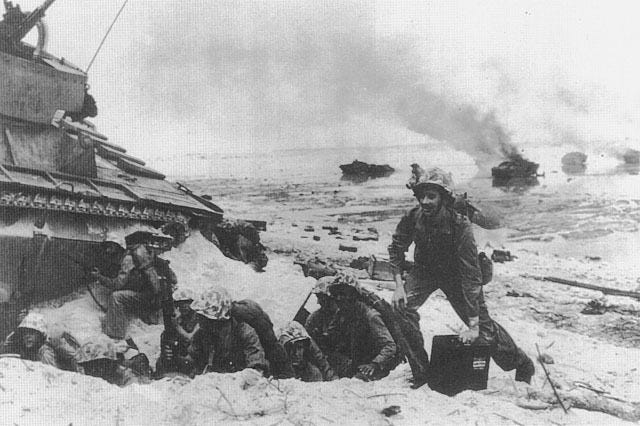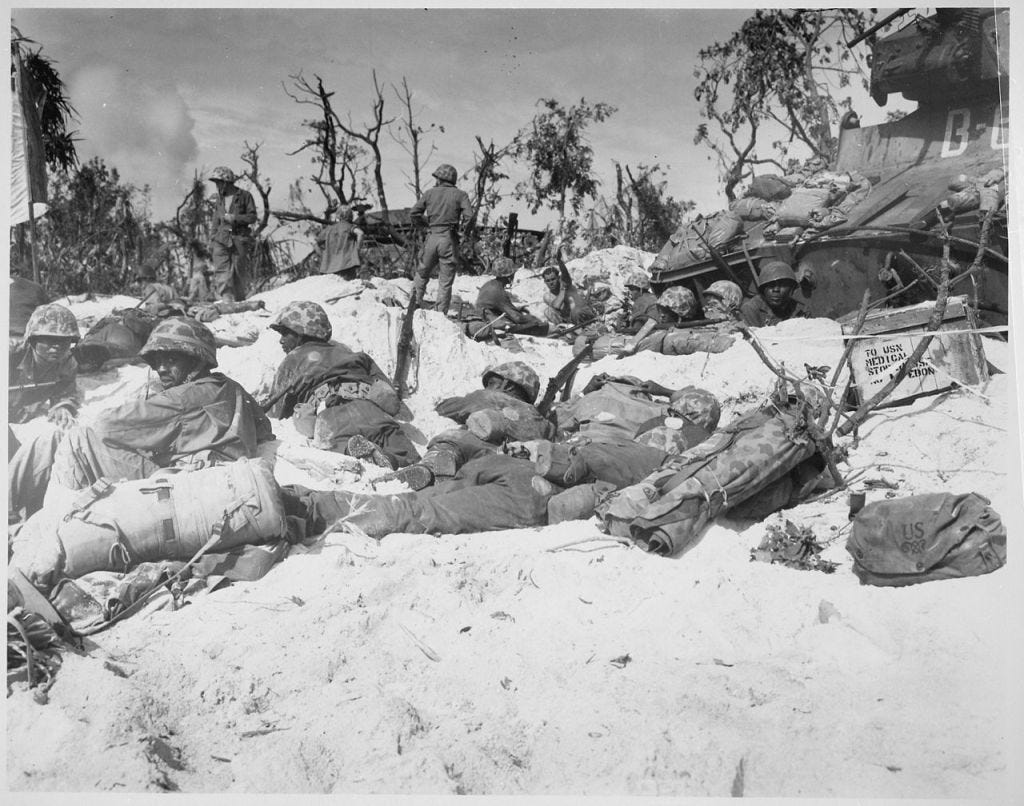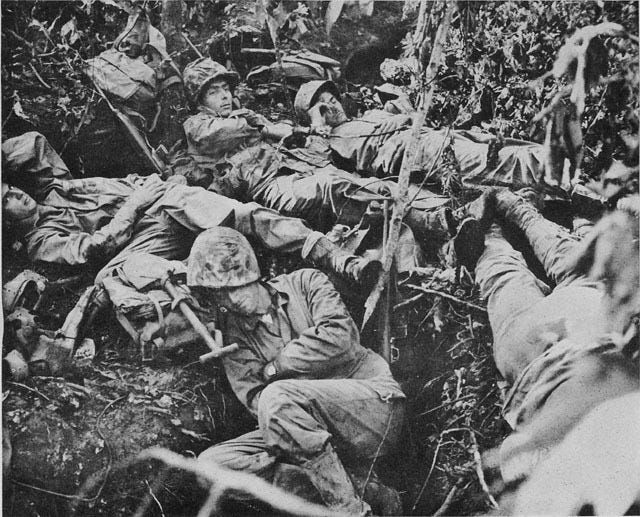Peleliu: Hitting the beach with the Marines
Over three days in mid-September 1944, Allied warships and airplanes bombarded seemingly every inch of a tiny Pacific island called Peleliu. New York Times correspondent George Horne, watching from a heavy cruiser offshore on September 14, called it "one of the most astonishing exhibitions that experienced Navy men had seen in this war." But something didn't seem quite right.
For this important bastion of the Japanese inner defense perimeter was too still, too ominously supine under the incessant gun and bomb hammering. Thousands of men wearing battle helmets watched the beaches and hills vainly for signs of life but there was no movement. They wondered how many eyes peered back from Peleliu and whether the shaken five miles of coral and limestone might not stir angrily in its caves and holes tomorrow morning when the first waves go in. ...
The obvious result of this prodigal expenditure of hot steel is impressive. The practical result will be known tomorrow when the men go over the reefs. By H-hour the Navy will have done everything possible in preparation. It will be up to the assaulting forces thereafter and all hands are hoping the torn, dusty island is as dead as it seems to be.
The uneasiness expressed by Horne was validated when elements of the 1st Marine Division hit the beach shortly after 8:30 a.m. on September 15. As amphibious vehicles crossed the reef and rolled up onto the sand, Horne wrote, "the Japanese crawled from caves and dens and tore into the invasion forces with machine guns, tanks and mortar fire."
The enemy was well equipped with guns and tanks and deeply dug in after years of preparations. The hills dominating the important airfield appear honeycombed with emplacements. From the sky control station of this heavy cruiser we could plainly see beach houses and buried pillboxes.
For several hours the struggle raged bitterly while we hammered a high knoll where four window-like openings were plainly visible. We poured in shells and would close up a gunport only to see the Japanese had shoveled it clear again.
Gene Sherman of the Los Angeles Times described similar frustrations in his initial dispatch from the island that day:
The beach scene presented a little confusion under the shell-shredded palm trees. Some early difficulty was caused by Jap rathole pillboxes on the beach level. One sniper was operating in one of the pillboxes six hours after the leathernecks had landed.
Late in the morning, Horne's ship took onboard a marine back from shore with a shrapnel hole in his leg. When a sailor asked him how things were going on the beach, he responded: "It's the same old story. You can put all the steel in Pittsburgh in there and they still come out of holes when we land."
That hallmark would hold true throughout the Pacific campaign, as Japanese defenders absorbed the initial punishment in meticulously planned defensive positions and waited for the invaders to come to them. Invariably outnumbered -- by a factor of about 4 to 1 on Peleliu -- the Japanese tried to inflict maximum damage as they fought quite literally to the last man.
Though by this point in the war that no-surrender mindset was well-known to U.S. troops, they still had trouble gauging how long it might take to achieve victory at a given objective. As dark fell on September 15, Gene Sherman asked a high-ranking marine officer if he considered the landing successful. He replied: "The island is ours. We are on it."
The latter statement was indisputable, but it would take longer than any of the Americans imagined for the former to be fully accurate.
The handful of correspondents who stayed ashore experienced that tenuous grasp firsthand. Lisle Shoemaker topped his second-day United Press story with the irresistible dateline "IN A FOX HOLE ON PELELIU ISLAND, WITH MARINE ASSAULT FORCES"
Japanese snipers, emerging from their caves, infiltrated the left flank of our newly won beachhead and kept the marines here discouragingly pinned down last night. Today the snipers are being mopped up, slowly.
Bill Hipple of Newsweek and I spent the night in this hastily dug two-man fox hole and throughout the hours of darkness tracers and bullets whined overhead. The enemy, blasted but unbroken by our tremendous pre-invasion bombardment, came out of their hiding places in a small, wooded section.
Shoemaker described a late-night attempt by 12 Japanese tanks to break through to the beach from the airfield that was the invaders' objective on the island. Three would break through Allied lines but were eventually destroyed, he wrote. "It is now 9 a.m. and sorely needed artillery is whooshing big shells into the hill on the left, while assault troops inch their way forward, still subjected to sniper fire."
As the battle rolled on, Shoemaker, Horne and others on the scene singled out Navy corpsmen and stretcher bearers for their heroic efforts in getting the wounded out of the line of fire and back to relative safety for treatment. Horne devoted an entire dispatch to an anonymous young corpsman who shepherded 13 wounded men into an amphibious tank and, unable to find a hospital ship, directed the vehicle to Horne's heavy cruiser.
Our deck went into action. A ladder and lines went overside, seamen descended to the amphibious tank with stretchers and a junior surgeon went down with blood plasma and morphine.
He did one fine job dressing those wounds, the surgeon said, and saved some lives, but the corpsman was sad, for he had lost plasma ashore and he had run out of morphine, so when the suffering men pleaded for it he would have to say no.
"They asked me for morphine and I could not give it to them," he kept repeating as he was led below and later when the doctor said, "You've done a fine job," he would shake his head. He had failed on the job, he thought. Finally he went to sleep.
Among those who might have assisted the corpsman in getting the wounded back to the beach were men of the 7th Marine Ammunition Company, a Black unit whose members were asked to volunteer as stretcher bearers early in the campaign. Marine combat correspondent Vic Kalman wrote in a story that appeared in Black newspapers like the Baltimore Afro-American and the New York Age in late October and early November:
For 96 hours, with only a few hours' sleep each night, the men hauled ammunition, water and food to the front lines and carried wounded back to the hospital, often dashing through machine gun fire to reach the wounded marines.
"We knew they were losing blood, so we practically had to run all the way back to the hospital," said Pvt. Robert J. McCloud, 20, of Raleigh, N.C., who left a defense job at the Norfolk Navy Yard to join the marines.
They trudged almost a mile with the wounded, arriving at the hospital in time to save dozens of lives. They were handicapped by crushing heat the first two days, a driving rain the third, and mud up to their knees the fourth day.
Their work in aiding the wounded aside, those men's efforts in replenishing the marines' water supply was critical, as Gene Sherman noted in the jarring conclusion to his story filed September 16:
My heart wrenched to watch the weary fighters in the scorching sun cluster eagerly around the water cans lugged to the front lines. The beach is still being fired on by mortars sporadically.
A tableau against the setting of a ripped shoreline is this poignant picture of the war: The waves lap at a naked marine whose body was burned yesterday in a shell explosion. He lies with his arms upraised. Another marine kneels with bowed head in prayer at an ammunition box.
The 5th Marine Regiment took control of the airfield, and by September 18 Marine Corps observation planes were able to land there, despite continued shelling of the north end of the facility by the Japanese. A little over a week later, F4U Corsairs began operating from the airfield, providing close air support and continuing painstaking attempts to ferret out the Japanese defenders.
By then, the marines had a better grasp of what they were up against. Maj. Gen. William H. Rupertus, commander of the 1st Marine Division, told correspondents on September 19 that he believed Peleliu "was fortified with more defenses per square yard than any other island in the Pacific.
In the same story, Gene Sherman passed along the U.S. estimate that some 5,500 enemy troops had been killed to that point. "We have about 400 more to kill," Rupertus said. "The Japs are now pushed into the hill areas, where they are well dug in. It is just going to take manpower to comb them out."
In the end, estimated Japanese losses would number nearly 11,000, and it would take two more months to get there. By then, the Army's 81st Infantry Division made up the majority of Allied forces on the islands, as the Marines had suffered horrific casualties.
The battle wasn't considered officially over until November 27, though some three dozen Japanese soldiers would famously remain in caves for two and a half more years before surrendering in April 1947.








